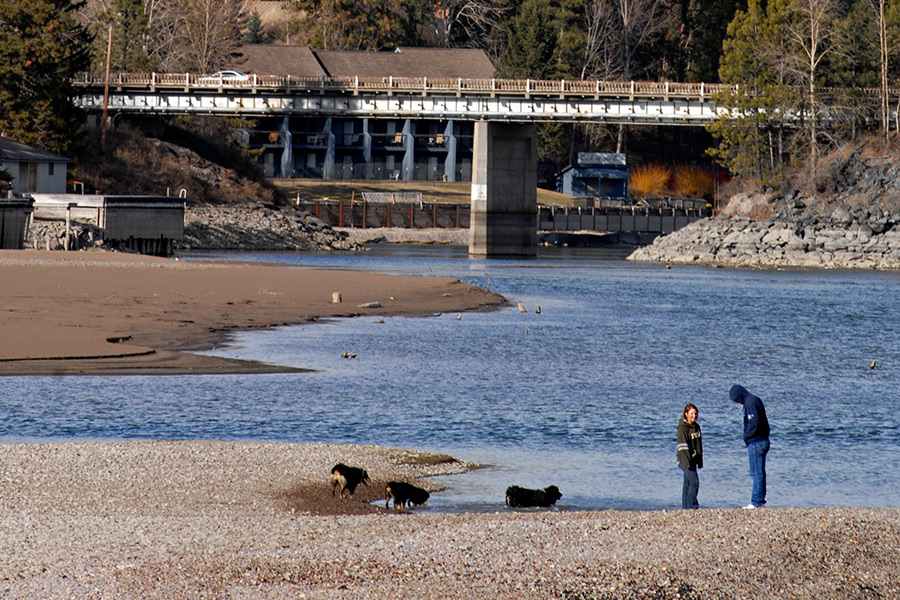The Flathead County Commission gave its approval on July 21 for a rural special improvement district in Bigfork to help pay the cost of a new stormwater mitigation system, though the board made the boundary for the RSID smaller than originally anticipated.
The Bigfork stormwater project has been ongoing for seven years, seeking to mitigate the sediment and pollution that drain into Flathead Lake and the Swan River, and the first few phases of the project have been completed on Grand Drive and the northern section of Electric Avenue.
That includes a hydrodynamic separator on the south side of Lake Avenue, which removes sediments in stormwater runoff before passing into the larger system. This system also traps oil, which can be vacuumed out during maintenance.
Stormwater runoff then enters the Jellyfish system – a filtration system with up to 20 arms. The Jellyfish, in conjunction with the hydrodynamic separator, is expected to treat nearly all of the yearly runoff.
So far, these systems are working well. The post-construction report shows sediment making its way to the lake has decreased by 10 times the amount that was originally measure pre-construction, according to Sue Hanson, the former chairperson of the Bigfork Stormwater Advisory Committee.
“The numbers are astounding, with how much we’re pulling out compared to the earlier testing,” Hanson said.
The final two phases of the project run down the south end of Electric Avenue, down to the steel bridge and up to the intersection with Highways 209 and 35.
Hanson said that despite $1.3 million in funding coming from various state and federal grants, it has always been the project’s intent to create an RSID to help pay for stormwater mitigation, including maintenance on the equipment.
The advisory committee suggested using the Bigfork Water and Sewer District as the boundary for the RSID, Hanson said, and a survey showed that 52 percent of survey responders said they would support the additional cost.
Within that boundary, there are about 3,148 parcel owners, Hanson said, meaning each one would be taxed an additional $34 per year over the 20 years of the RSID’s lifetime.
However, Commissioner Gary Krueger said he didn’t feel comfortable applying a new tax within that boundary, and said he would prefer the watershed boundary drawn up in earlier proposals. That boundary contains about 583 parcels, and Krueger said he believes that’s where the bulk of the pollution comes from.
“I tried to pick something that represented the area that was contributing to the pollution or contributing to the stormwater,” Krueger said in a recent interview.
Many of the new subdivisions in the Bigfork Water and Sewer District are already following and paying for stormwater mitigation, Krueger said, and adding them to the new RSID would be akin to double dipping.
“I had some issues with the boundary as it was presented and proposed a boundary of the drainage area,” Krueger said during the July 21 hearing. “I could support going forward with the boundary of the drainage area; I have trouble doing it with the other boundaries, the original boundaries.”
Commissioner Pam Holmquist agreed, and Commissioner Cal Scott didn’t have any comment.
But Hanson and other project supporters said that most of the pollutants come from people driving on the roads through Bigfork, and the way the watershed works shows that groundwater from beyond Krueger’s boundary contribute to the pollution as well.
“The commissioners failed to grasp that the pollution doesn’t just come from that small drainage area; it comes from all the road traffic that comes downtown Bigfork,” Hanson said in an interview after the July 21 hearing.
Using the drainage area boundary, the roughly 583 parcel owners would face about $200 per year in taxes. Parcel owners have 90 days to protest the RSID, and the commission could terminate it due to the protestations, which is what Hanson believes will happen, putting the remainder of the project in jeopardy.
“Of course that (RSID) has no chance of passing,” Hanson said. “I wouldn’t support that, that isn’t right.”
In an interview after the hearing, Holmquist said she didn’t believe the new, smaller boundary was an attempt on the commission’s part to kill the RSID, but that the approved boundary was fairer on the Bigfork taxpayers.
“I think we just gave it a lot of thought,” Holmquist said. “It seemed fair to me that we charge those that are in the geographical area.”
Holmquist also said she expected the stormwater advisory committee to be pleased that the RSID is even moving forward since it has been in limbo for about two years.
“In my mind it was just time to see if the community really did want it,” she said.
The RSID, which will have considerable administrative costs due to boundary mapping, distribution and management, will be paid for through a $100,000 grant from the state Department of Natural Resources and Conservation.
